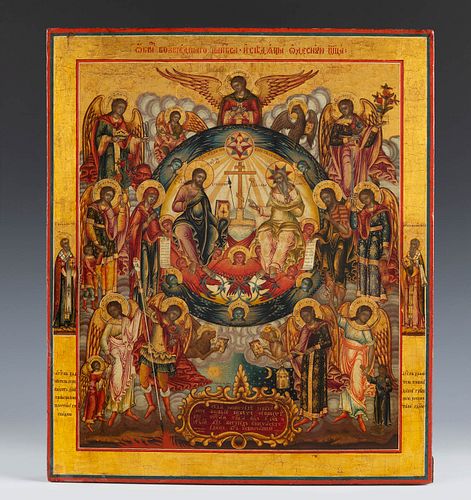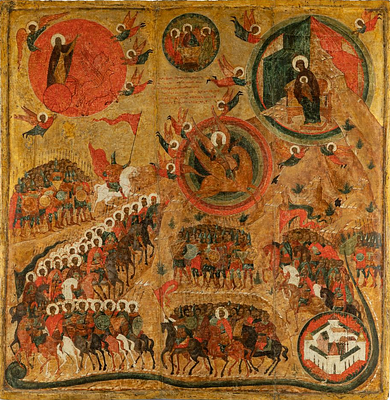Vetka School, second half of the 19th century. "The Holy Trinity of the New Testament. The Paternity". Tempera, gold leaf on panel.
Lot 29
About Seller
Setdart Auction House
Carrer Aragó 346
Barcelona
Spain
Setdart Subastas was born in 2004 and is currently the first online art auction in Spain with solidity, prestige and reliability guaranteed by our more than 60,000 users. Setdart has a young, dynamic and enterprising team ready to successfully manage the purchase and sale of art works through custom...Read more
Estimate:
EUR€2,500 - EUR€3,000
$2,604.17 - $3,125
Absentee vs Live bid
Two ways to bid:
- Leave a max absentee bid and the platform will bid on your behalf up to your maximum bid during the live auction.
- Bid live during the auction and your bids will be submitted real-time to the auctioneer.
Bid Increments
| Price | Bid Increment |
|---|---|
| EUR€0 | EUR€10 |
| EUR€200 | EUR€25 |
| EUR€500 | EUR€50 |
| EUR€1,000 | EUR€100 |
| EUR€3,000 | EUR€200 |
| EUR€5,000 | EUR€500 |
| EUR€10,000 | EUR€1,000 |
| EUR€20,000 | EUR€2,000 |
| EUR€50,000 | EUR€5,000 |
About Auction
By Setdart Auction House
Sep 23, 2021
Set Reminder
2021-09-23 10:00:00
2021-09-23 10:00:00
America/New_York
Bidsquare
Bidsquare : RUSSIAN ICONS
https://www.bidsquare.com/auctions/setdart-auction-house/russian-icons-7431
Setdart Auction House sofia@setdart.com
Setdart Auction House sofia@setdart.com
- Lot Description
Vetka School, second half of the 19th century. "The Holy Trinity of the New Testament. The Paternity". Tempera, gold leaf on panel. Measurements: 44 x 38 cm. This is one of the rarest representations of the Holy Trinity in orthodox iconography. It belongs to the "Paternity" typology, whose main protagonists are the Father God, the Son and the Holy Spirit, among other celestial beings and saints. For a long time the Orthodox Church forbade the depiction of the Father God as an old man with a long beard and grey hair, following the Western prototype. Only around the 10th century in the Byzantine Empire, and around the 15th century in the territory of the Old Rus, in Novgorod, under the influence of Western European canons, does this iconography of the New Testament appear. God the Father Sebaoth, on the right, and Jesus Christ, on the left, share the throne, this composition is called "Synthronos". Between them, in a mystical spherical mandorla, rises the dove, symbol of the Holy Spirit. This iconography met, and still meets, much rejection, and even today it is not officially accepted by the Russian Orthodox Church. However, from the 16th century onwards this representation became very popular in Russia, especially among Old Believers, and Russian icon painters have enriched the traditional composition with other elements. In our icon, for example, they added to the central composition the figures of the Virgin and St. John the Baptist, creating a Deesis, and around them they included guardian angels, the seven archangels, the tetramorphs, culminating the composition with allegorical landscapes. In the case of the lot under consideration, it represents the best example of this modified iconography, and it also belongs to a particular school, the Vetka school, located in the territory of contemporary Belarus. Old Believers settled in the southern parts of Russia, in Ukraine and in the territory of contemporary Belarus towards the end of the 17th century in order to find a religious refuge. By the mid-18th century there were as many as 100,000 Old Believers, making it one of the most important spiritual centres in Russia. Due to the isolation of the region and the transfer of knowledge of icon painting from generation to generation until the 20th century, an original style of painting was formed here, which belongs in its own right to Russian, Belarusian and Ukrainian culture at the same time. Because of their decorative character, Vetka icons are easily recognisable: they are spectacular and festive, filled with the light of gold and bright, open colours, just like the auctioned icon. Local craftsmen used traditional materials: local wood base, preparatory layers of pavolok and levkas, and tempera paints. Preserving the ancient concept of gold as a symbol of divine light, they covered the edges and background of the icon with gold or its imitation. The border was usually painted in red and blue, the inner frame in red with a thin line of white lime, and the margins were filled with inscriptions in cinnabar. In general the icons of the Vetka school have a very recognisable style, but at the same time they follow traditional processes and patterns. They are inspired by 17th- and 18th-century icon painting, especially from Yaroslavl and Moscow. That is why even the most modern icons have the air of antiquity, especially in the faces of the saints. Of course, to find an icon of the Vetka school today is a find, therefore the presented icons have a great cultural, artistic and historical value.
- Shipping Info
-
In-house shipping available. Please inquire at admin@setdart.com.
-
- Buyer's Premium



 EUR
EUR CAD
CAD AUD
AUD GBP
GBP MXN
MXN HKD
HKD CNY
CNY MYR
MYR SEK
SEK SGD
SGD CHF
CHF THB
THB
















